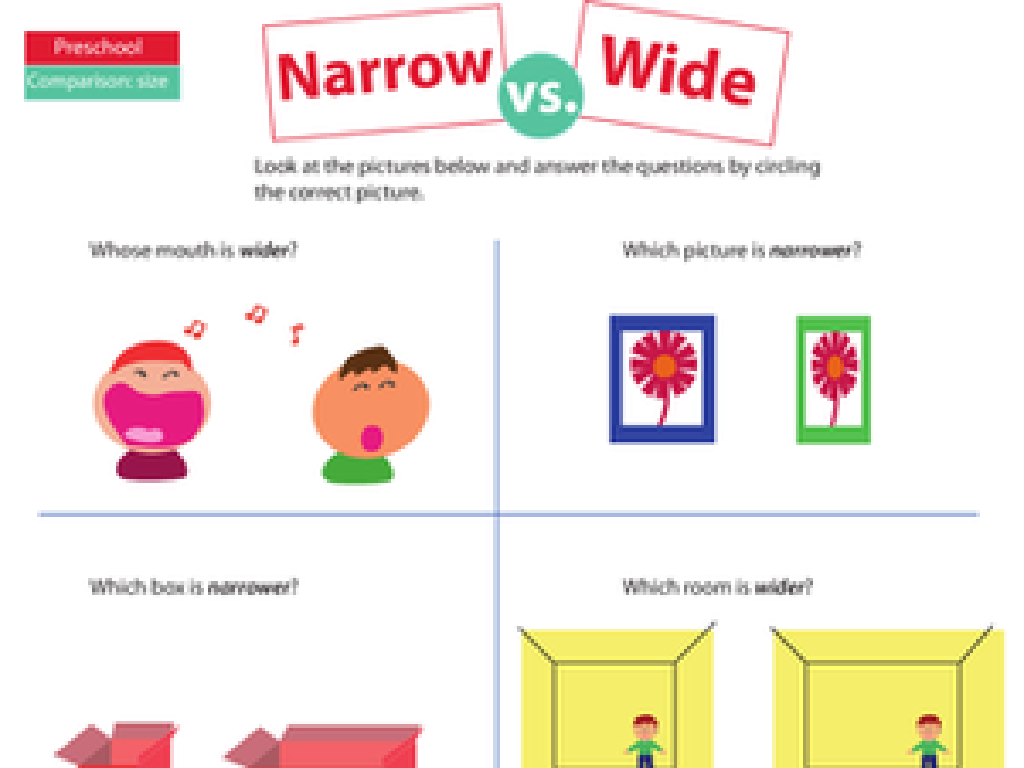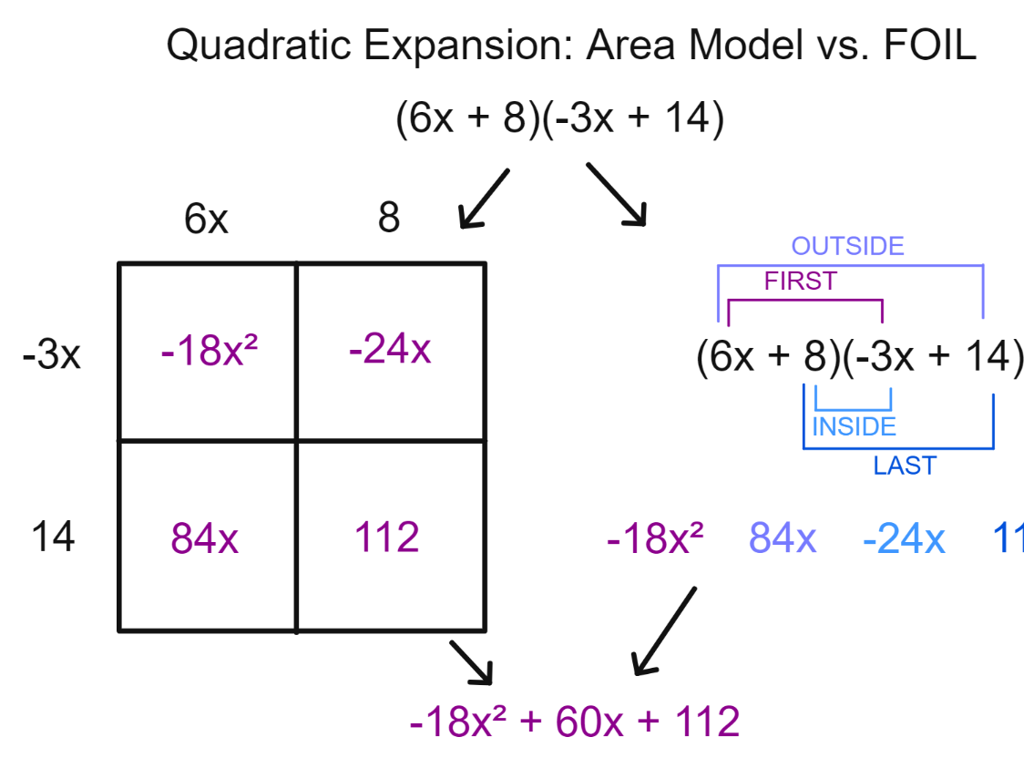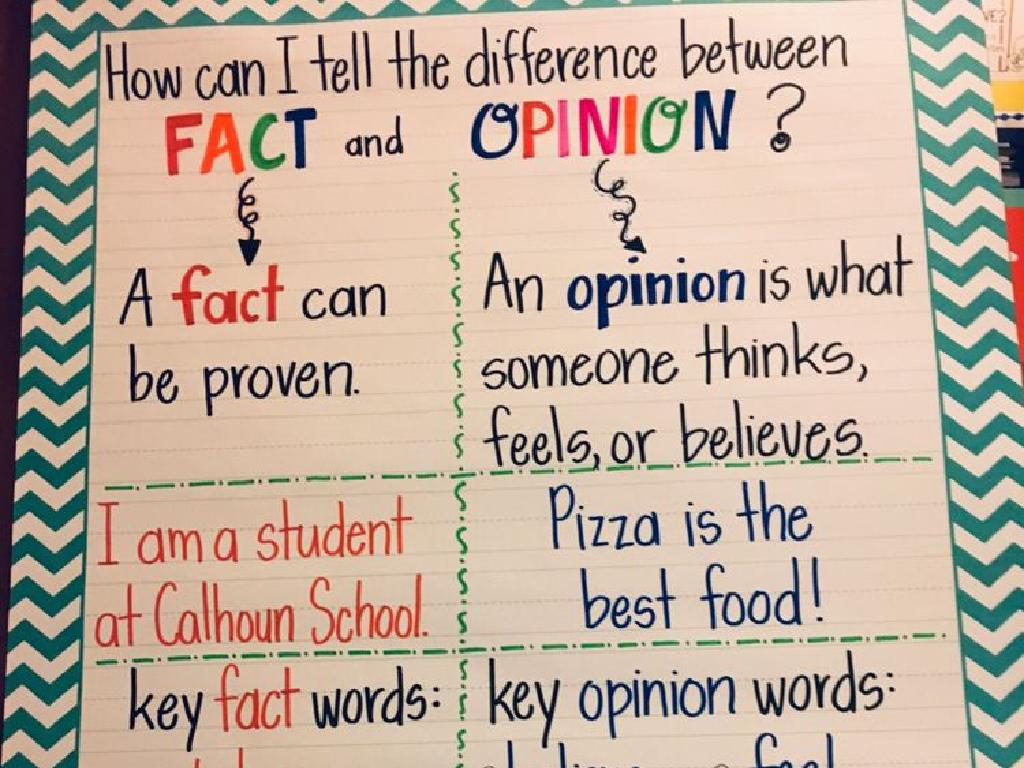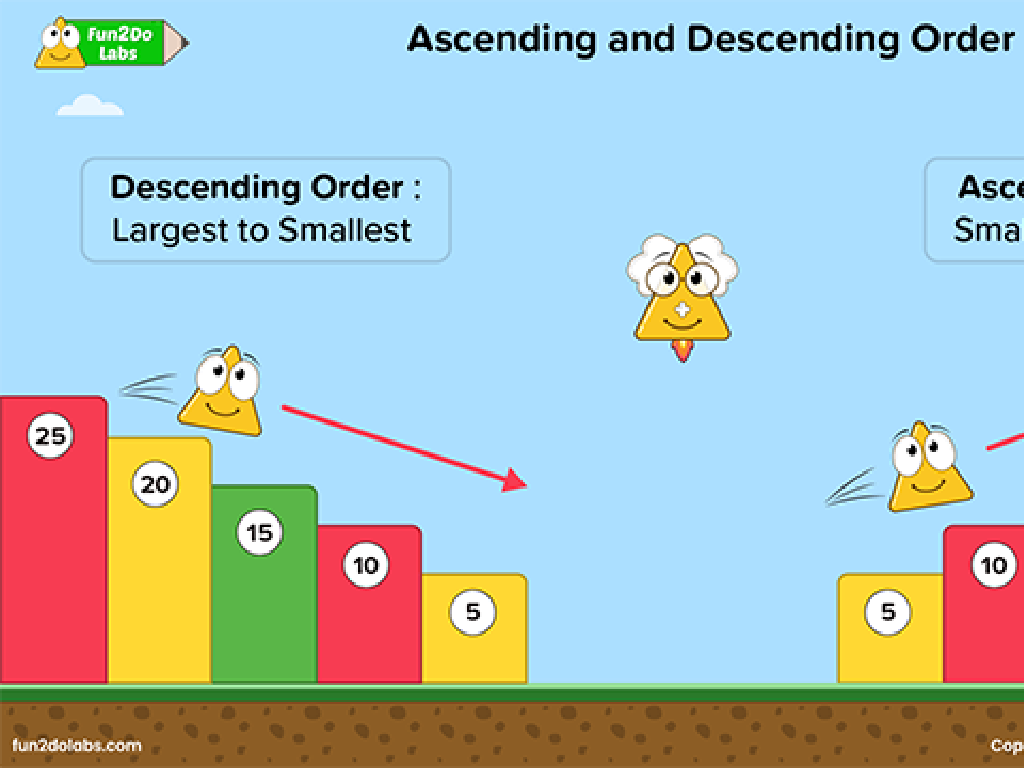Distinguish Characters' Points Of View
Subject: Language arts
Grade: Third grade
Topic: Point Of View
Please LOG IN to download the presentation. Access is available to registered users only.
View More Content
Exploring Characters’ Points of View
– Learn about Point of View
– How characters think and feel
– Characters in stories have thoughts and feelings that may be different from ours or others’.
– Importance of characters’ views
– Knowing a character’s point of view helps us understand their actions and the story better.
– Activity: Guess the Viewpoint!
– We’ll play a game where you guess a character’s point of view from a story we read.
|
This slide introduces the concept of Point of View to third-grade students, emphasizing the importance of understanding characters’ perspectives in literature. Begin by explaining that Point of View is the way a character looks at events happening in the story. Discuss how everyone has different thoughts and feelings, and characters in stories are no different. Explain why it’s important to understand these perspectives, as it helps us to relate to the characters and understand why they do what they do. Conclude with an engaging class activity where students guess the viewpoint of various characters from a familiar story, encouraging them to use clues from the text to support their answers. This activity will help solidify their understanding of the concept.
Exploring Points of View in Stories
– What is point of view?
– It’s the ‘eyes’ through which we see the story
– Types of point of view
– First person: ‘I’, Second person: ‘You’, Third person: ‘He/She/They’
– Characters have unique views
– Like how you and a friend might see a game differently
– Understanding different perspectives
|
This slide introduces the concept of point of view to third-grade students, explaining that it’s the perspective from which a story is narrated. Highlight the three main types of point of view: first person, second person, and third person, using personal pronouns as a guide. Emphasize that characters in stories can have different points of view, just like people in real life. Use examples from familiar stories or everyday situations to illustrate how different characters might see the same event in unique ways. Encourage students to think about their own perspectives and how they might differ from others’.
Exploring First Person Point of View
– ‘I’ or ‘me’ tells the story
– The storyteller is part of the story.
– See the world through a character
– Imagine wearing their shoes and looking around.
– Read an example story
– Listen as we read, notice the use of ‘I’ or ‘me’.
|
This slide introduces the concept of the first person point of view in storytelling, where the narrator is a character within the story, often the protagonist. Use ‘I’ or ‘me’ to indicate that the character is telling the story from their own perspective. It’s like looking through the character’s eyes, hearing their thoughts, and feeling their feelings. To illustrate this, read a short example story or passage where the first person point of view is used. Ask the students to listen carefully to how the story is told and to identify words that show the character’s personal perspective. After reading, discuss how this point of view might change the way we understand the story. Encourage students to think about how they would feel if they were the character.
Understanding Third Person Point of View
– Narrator is outside the story
– Uses ‘he’, ‘she’, ‘they’
– Look for these pronouns in stories
– Reveals characters’ thoughts
– Think about how we learn what characters are thinking
– Shows various feelings
– Notice how we understand characters’ emotions
|
This slide introduces the concept of the third person point of view in storytelling. It’s important to explain to the students that in this perspective, the narrator is not a character in the story but an outside observer. Emphasize the use of pronouns ‘he’, ‘she’, and ‘they’ as a key feature of this point of view. Discuss how this perspective allows the reader to see into the minds of different characters, understanding their thoughts and feelings. Use examples from familiar stories and encourage students to share examples they’ve read. This will help them recognize the third person point of view in their reading and understand the narrator’s role in storytelling.
Comparing Characters’ Points of View
– Different views on the same event
– Cat vs. Mouse: A chase perspective
– A cat might see it as fun, while a mouse as scary
– Discuss with a classmate
– Share ideas on how each character feels
– Think about their feelings
– Imagine being in their ‘paws’, how would you feel?
|
This slide aims to teach students that different characters can have unique perspectives on the same event. Use the example of a cat and mouse to illustrate this concept. The cat may view the chase as a playful game, while the mouse sees it as a threatening situation. Encourage students to pair up and discuss other examples of how characters might view the same event differently, focusing on their emotions and motivations. This activity will help students understand that point of view is shaped by individual experiences and feelings. It’s a fundamental skill in developing empathy and critical thinking when reading stories.
Identifying Characters’ Points of View
– Clues for point of view
– Look for hints in the story that show us who is telling the tale.
– Pronouns reveal the speaker
– ‘I’ for first person, ‘you’ for second person, ‘he/she/they’ for third person.
– What characters see and know
– Can the character know everything or just their own feelings?
– Characters sharing their thoughts
– When characters speak, they let us peek into their minds.
|
This slide aims to teach students how to identify the narrator’s perspective in a story. Start by explaining that point of view is how the narrator tells us about what’s happening. Provide examples of pronouns that signal different points of view: ‘I’ for first person, ‘you’ for second person, and ‘he/she/they’ for third person. Discuss how a character’s knowledge is limited to their own experiences unless the story is told from a third-person omniscient point of view. Encourage students to listen to what characters say and how they react to understand their thoughts and feelings. Use a familiar story to practice identifying these clues.
Activity Time: Point of View Skits
– Split into groups for skit creation
– Each group acts out the same story
– Show different character viewpoints
– Present and explain viewpoints
– Think about how your character feels and why
|
This activity is designed to help students understand that different characters can have unique perspectives in the same situation. Divide the class into small groups and assign them the task of creating short skits based on a common story. Each group will interpret the story from the point of view of a different character. Encourage creativity and discussion within the groups to explore their character’s feelings and motivations. After the skits, each group will present their version of the story and explain why their character sees things the way they do. Possible variations of the activity could include using familiar fairy tales, current events, or scenarios from other stories read in class. This will help students grasp the concept of ‘point of view’ and its importance in storytelling and comprehension.
Review and Reflect: Character Perspectives
– Recap on point of view
– Importance of different viewpoints
– Understanding all sides helps empathy and communication
– Share skit reflections
– What did you enjoy or learn from the skits?
– Discuss personal insights
– How can recognizing viewpoints affect our thoughts?
|
This slide aims to consolidate the day’s learning by reflecting on the concept of point of view. Start by asking students to summarize what they’ve learned about how different characters can have unique perspectives in stories. Emphasize the importance of understanding these different points of view, as it can enhance empathy and improve how we communicate with others. Encourage students to share their thoughts on the skits performed during class, focusing on what they found interesting or what they learned. Finally, facilitate a discussion on how recognizing different viewpoints can influence our own thoughts and actions. This reflection will help students internalize the lessons on point of view and apply them to their reading and social interactions.
Class Activity: Exploring Character Perspectives
– Pick a character from our stories
– Write a paragraph in their shoes
– Imagine what they think and feel
– Think like the character
– How do they see the story unfold?
– Get ready to share with everyone
|
This activity is designed to help students understand that different characters can have unique perspectives in the same story. Encourage them to choose a character they felt connected to or curious about. Guide them to write from the first-person point of view, using ‘I’ to express the character’s thoughts and feelings. Remind them to consider how the character’s viewpoint might differ from others in the story. After writing, create a supportive environment for students to share their paragraphs, fostering a discussion on how perspectives can change the way we interpret stories. Offer prompts or sentence starters for students who may need assistance beginning their paragraphs.






